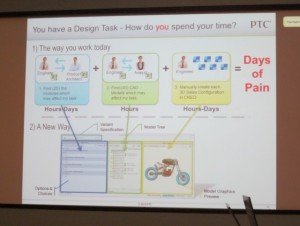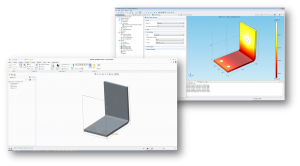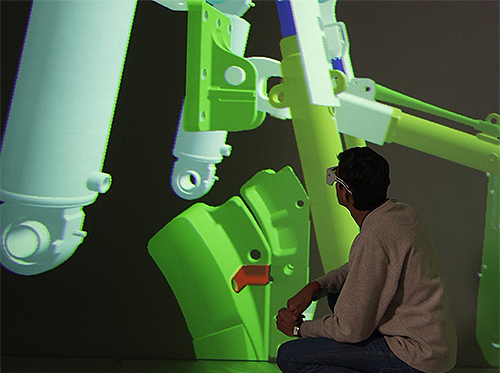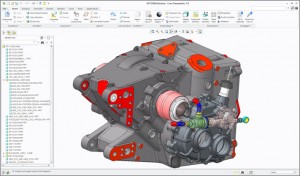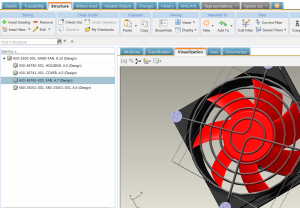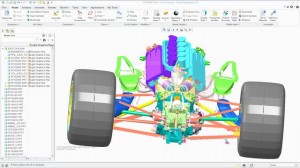 This week, PRC announced Creo 2.0 and Windchill 10.1. These aren’t big releases in the grand scheme of things, but they are important releases, and show that PTC is working hard to deliver on what it’s promised.
This week, PRC announced Creo 2.0 and Windchill 10.1. These aren’t big releases in the grand scheme of things, but they are important releases, and show that PTC is working hard to deliver on what it’s promised.
Creo 2.0
This release includes fresh and updated releases of the 9 existing Creo apps, and adds a 10th new app called Options Modeler, which supports design-to-order and assemble-to-order. Picture, if you will, the kind of capabilities that major PTC customers such as Caterpillar and Deere might need, and you’ll get an idea of what Options Modeler is about. It integrates with Windchill, and can handle arbitrarily large and complex assemblies. It’s available today an extension to Creo Parametric and will be available as a stand-alone app in June.
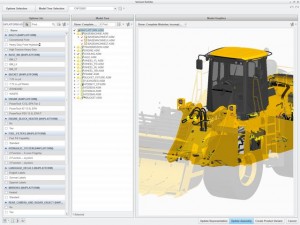 With the new release, PTC is offering the free Creo Sketch app for Apple devices, and Creo Layout for doing 2D layouts as a front-end to 3D design.
With the new release, PTC is offering the free Creo Sketch app for Apple devices, and Creo Layout for doing 2D layouts as a front-end to 3D design.
Overall, PTC has added more than 490 enhancements througought the Creo like. PTC says that the quality, performance and usability of version 2.0 of the entire Creo family is dramatically improved from version 1.0.
Windchill 10.1
PTC has integrated Integrity with Windchill, and are leveraging it for comprehensive requirements management. Integrity is the tool PTC customers will use to capture and, ultimately, trace customer requirements across the product development lifecycle to ensure the product delivered most perfectly matches the product desired. Of particular note: PTC is using Integrity to manage requirements in its own development processes.
PTC has enhanced Windchill in several key areas, adding capabilities to help users ensure compliance with government relations and with industry quality standards. One important enhancement is the ability to monitor for the use of “conflict minerals” in a given product. They’ve also improved how reliability analysis is communicated, to ensure faster resolution of issues stemming from customer complaints.
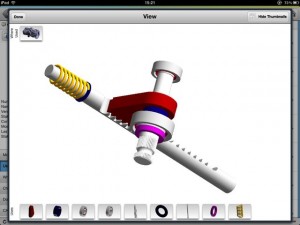 With the introduction of Windchill Mobile, PTC is now supporting the iPad and iPhone. The software includes the “shake and break” feature demonstrated at last year’s PlanetPTC Live, in which users can “explode” the diagram of a product assembly by simply shaking their mobile device to see the internal parts in greater detail. I suggested an Etch-a-Sketch function, where turning it upside down and shaking it would erase your project files—but the PTC people told me that Microsoft already had a patent on that function, back from the days of Windows ME.
With the introduction of Windchill Mobile, PTC is now supporting the iPad and iPhone. The software includes the “shake and break” feature demonstrated at last year’s PlanetPTC Live, in which users can “explode” the diagram of a product assembly by simply shaking their mobile device to see the internal parts in greater detail. I suggested an Etch-a-Sketch function, where turning it upside down and shaking it would erase your project files—but the PTC people told me that Microsoft already had a patent on that function, back from the days of Windows ME.
The official press releases follow:
PTC Advances MCAD Strategy with Release of Creo 2.0
Latest Release Introduces New App for Modular Product Design, Enhances Apps for Concept Design, and Improves User Productivity Across Creo Family
NEEDHAM, MA. – April 9, 2012 – PTC (Nasdaq: PMTC) today announced Creo® 2.0, the latest release of its revolutionary new generation of product design software. Last June, PTC challenged the industry paradigm with the introduction of the first nine “apps” in its Creo family – conceived, in part, to enable a much wider range of roles to contribute to the design process with a set of integrated, purpose-built tools. With Creo 2.0, PTC introduces a new role-specific app supporting modular product design that extends how organizations can approach concept design, and delivers significant productivity enhancements to its existing Creo apps.
“The release of Creo 2.0 demonstrates PTC’s unwavering commitment to deliver against our Creo strategy and solve the chronic challenges customers face with traditional CAD tools,” said Michael Campbell, divisional general manager MCAD segment, PTC. “Built on PTC’s heritage of innovation, Creo rethinks the very nature of product design, increasing collaboration and protecting data fidelity across any user role, any design mode, or any data source. Today, PTC is also delivering the first technology component in its vision for managing modular product designs driven by the bill of materials.”
Modular Product Design
With Creo 2.0, PTC introduces a 10th app to the Creo family – Creo Options Modeler™ – a new role-specific app built for designers who need to create or validate modular product designs in 3D early in a design cycle. The new app, available this summer, delivers a dedicated, easy-to-use, powerful set of capabilities to build accurate, up-to-date, precise 3D-based product assemblies, irrespective of size or complexity. When used with Creo Parametric™, Creo Options Modeler enables teams to validate precise mass, center of gravity, and even check and resolve critical issues like interference for modular designs.
Creo Options Modeler contributes to PTC’s AnyBOM™ Assembly technology vision, which promises to give teams the power and scalability needed to create, validate and reuse information for modular product architectures. By combining Creo Options Modeler with PTC’s Windchill® product lifecycle management software, manufacturers can generate and validate precise 3D representations of product configurations defined by an individual bill of materials.
By enabling easier reuse of existing 3D models and through innovative interface tagging, the new app can reduce process errors and engineering rework. As a member of the Creo product family, Creo Options Modeler also seamlessly leverages and shares data between other Creo apps, and with other people involved in the design process and beyond, further increasing detailed design and downstream process productivity.
Rethinking Concept Design
Many companies prefer to start concept designs in 2D to quickly explore multiple options before moving to build more complex 3D models. With Creo 2.0, PTC delivers on its vision for enabling companies to make the most of this early stage of their product development process. The new releases of Creo Parametric, Creo Direct™, the free Creo Sketch™ (now available on Mac OS X with this release), and Creo Layout™ combine to greatly enhance collaboration, innovation and design exploration during concept design. Since all Creo apps share a common data model, 2D geometry and design data can be easily shared by all users and apps and can be re-used later in the design process to accelerate the transition to the detailed design phase.
In Creo Layout 2.0, PTC is helping to solve the specific problem of transitioning from 2D to 3D, allowing users to easily create a layout of complex assemblies, quickly explore design alternatives, import a variety of 2D CAD file types, sketch and modify 2D geometry, organize information with groups, tags and structure as well as dimensions, notes and tables. Once created, a 2D design in Creo Layout can serve as the basis for 3D models, allowing users to create assemblies in 2D or reference 2D geometry to create part features, and any changes made in 2D are reflected in 3D upon regeneration.
Productivity Enhancements
In the new release, PTC delivers more than 490 enhancements to the Creo app family, all designed to optimize the user experience and increase design productivity.
Creo Parametric enables increased productivity and streamlining of the overall product design process with:
· Freeform Surfaces – With the enhanced freestyle capabilities, designers can quickly and easily create more refined surfaces with higher levels of detail while still maintaining top level control over the general freeform shape. This significantly reduces the time to move concepts to precise, highly-detailed aesthetic product designs.
· Cross-sections – Designers working in 3D cross-sections gain complete product insight with new, intuitive, and fast ways to create and dynamically re-position the sections, including instant access directly from the model tree. Real-time interference detection within a section together with 2D visualization helps designers fully visualize the design, design changes, and detect and address potential issues early. The new tools significantly enhance productivity when working in cross-sections and provide a rich design environment that accelerates the overall design process.
· Measure – The new streamlined measure tool offers significant performance and usability improvements. Designers can quickly gain detailed insight into key dimensions and measurements of any selected surface. By controlling how and where measured results are displayed on-screen, and allowing for simple re-use of the displayed values into other applications, such as a Word document, designers can improve the efficiency and accuracy of leveraging precise measurements during the design process.
· Track Changes – The new track changes capability in Creo Parametric allows designers to view, accept or reject model changes made by others using Creo Direct. Designers can now work with a broader range of roles across the company while still maintaining full control of how changes are reflected in the parametric model. This ensures design intent is fully maintained. Irrespective of modeling approach or Creo app, teams can now truly work together.
Overall, Creo Parametric delivers state-of-the-art user experience, new capabilities, automates common tasks, improves performance with streamlined workflows and enables dramatically improved overall design productivity.
Beyond Creo Parametric, PTC delivers significant enhancements to other Creo apps. New capabilities in Creo Direct help accelerate bid-proposals and early concept design. Casual users can now quickly and easily create new compelling 3D designs. They also can easily modify models by reference to existing geometry of available parts and assemblies or quickly, but precisely place multiple parts and assemblies into position with the new intelligent snapping capabilities.
And as Creo Direct seamlessly works with Creo Parametric and other Creo apps, any 3D design can be shared by users across the enterprise design process.
In addition, this latest release greatly simplifies the installation process for Creo, only downloading and installing the Creo apps specific to a customer’s environment and license entitlement. This speeds download and significantly simplifies installation and configuration enabling teams to get up and running with Creo more quickly than ever before.
More information will be shared at PTC’s upcoming annual user event, PlanetPTC Live.
Additional Resources:
· Creo Product Page (website)
· Creo Options Modeler (website)
· Creo Parametric (datasheet)
· Creo Layout (datasheet)
· Creo 2.0 Frequently Asked Questions (FAQ)
· Creo 2.0 Top Ten Reasons to Upgrade (datasheet)
· Introduction to Creo Layout (video)
· Creo Ready Software and Hardware Partners
Availability
Creo Options Modeler is available for purchase today as an extension of Creo Parametric. It is expected to be available as a stand-alone app in June 2012. All other Creo 2.0 apps are available now.
About PTC
PTC (Nasdaq: PMTC) enables manufacturers to achieve maximum value from their product strategies with software and services designed to optimize key business processes throughout the entire product lifecycle – from conception and design to sourcing and service. PTC’s integral solution portfolio enables customers to unleash product innovation, improve collaboration and ensure product data integrity within engineering and across the enterprise, supply chain and service partner networks. Founded in 1985, PTC employs over 6,000 professionals serving more than 27,000 customers worldwide. More information can be found at www.ptc.com.
PTC Extends Windchill Capabilities, Integrates with Integrity
Company Leverages Integrity for Comprehensive Requirements Management
NEEDHAM, MA. – April 9, 2012 – PTC® (Nasdaq: PMTC) today announced the latest version of its Windchill® product lifecycle management (PLM) software, which is now also integrated with PTC’s recently acquired Integrity™ software system lifecycle management technology. Windchill 10.1 introduces sweeping enhancements to the product’s capabilities in a wide range of areas, while integrating Windchill with Integrity raises the bar for how manufacturers gather and manage requirements and trace related changes. In addition, Windchill Mobile™ is now available from the Apple iTunes store for the iPad and iPhone.
“At PTC, our goal is to help manufacturers find new ways to compete in their markets, and to make their success repeatable over time,” said Brian Shepherd, executive vice president, PLM Segment, PTC. “With this new version of Windchill, we’ve not only enhanced a number of critical functional areas, but we’ve also made major improvements to the user experience and serviceability of the product across-the-board. We believe that PTC is continuing to set the pace for the value companies can generate when they deploy enterprise-class PLM technology.”
Do More: Comprehensive Requirements Management from Integrity
Less than a year after being acquired by PTC Integrity is dramatically expanding PTC’s footprint of capabilities. Specifically, PTC has integrated Windchill and Integrity to combine the rich, collaborative requirements authoring and management capabilities of Integrity with the powerful “flow-down” traceability offered in Windchill. This combination delivers powerful, comprehensive requirements management capabilities and enables manufacturers to improve product quality, reduce rework and improve time to market.
In addition, Windchill now integrates with the software change and configuration management capabilities of Integrity – and other leading tools – to manage defects and issues, as well as enable software releases to be synchronized with product configurations.
Requirements gathering and management is one of the most critical aspects of a product’s lifecycle. According to industry analyst firm CIMdata, “Requirements management is all about balance—preventing one class of requirements from overriding another is critical. Effective requirements management ensures that the voice of the customer is captured and managed throughout the lifecycle of the product. This enables a company to design, build, and deliver products and services that meet or exceed their customers’ needs and expectations.”[1]
In addition, Windchill’s core configuration management capabilities have been further enhanced to provide advanced support for configurable products. Together with new digital mock-up capabilities in Creo® 2.0, these enhancements in Windchill contribute to PTC’s AnyBOM™ Assembly technology vision; promising to give teams the power and scalability needed to create, validate and reuse information for modular product architectures.
PTC is also extending the breadth of product-related content that can be managed in Windchill for retail and consumer product companies. With a new version of its FlexPLM technology, companies can now reference CAD models managed in a Windchill environment – giving retail product designers much greater visibility and understanding of how to work with products that have both hard and soft goods (e.g. a chair’s frame and fabric).
Know More: Track Compliance, Quality, Cost
In the critical area of compliance, PTC has extended Windchill’s capabilities for tracking and monitoring regulated materials use. For example, the recent Conflict Minerals legislation passed by the US Government drove the introduction of new management and reporting capabilities to help manufacturers identify and assess the compliance status of products containing the regulated minerals of tantalum, tin, tungsten, and gold and their many derivatives. This allows companies to effectively protect their corporate brands, mitigate risk of non-compliance with government regulations and customer requirements, and avoid possible fines and penalties.
To further assist manufacturers with their quality initiatives, PTC has enhanced how Windchill analyzes the latest product structure information to provide early and accurate insight into product reliability. For example, critical-to-quality characteristics identified in Creo are automatically communicated to Windchill Quality™ offerings for risk and reliability analysis, associating these characteristics with the test plans and manufacturing controls designed to ensure their quality. A new Windchill Customer Experience Management™ module provides a highly-structured and automated process flow to trace and respond to customer complaints about product quality. This enables a company to consistently resolve quality issues in a manner compliant with government regulations or quality management standards.
PTC has also enhanced how companies can accurately track product cost estimates and maintain related historical information by managing and displaying product cost information in multiple currencies.
Get More: Windchill Goes Mobile
With the new release, PTC is introducing a new Windchill Mobile app, giving users instant “anytime, anywhere” access to current product and process information. Windchill Mobile includes an innovative “shake and break” capability that allows users to explode a product assembly by simply shaking their mobile device to see the internal parts in greater detail. This helps companies improve worker productivity, regardless of whether they’re on the road, the manufacturing floor, or visiting a customer. Windchill Mobile is available today to download from the Apple iTunes store for both the iPad and iPhone. Windchill also now supports Apple users even if they aren’t on a mobile device with support for Mac OS X.
PTC has also simplified the Windchill system administration tools to improve reliability and lower overhead associated with running a Windchill installation. For example, the new PTC System Monitor continuously checks the Windchill production environment to give administrators greater visibility into system performance, allowing proactive detection of potential bottlenecks before they impact end users, and reducing time to repair.
Finally, Windchill continues to build on the dramatic improvements PTC introduced in its user experience, making great use of graphical information and further simplifying workflows to accelerate tasks. For example, the new Relationship Explorer allows users to visually navigate between related parts, documents, CAD designs, requirements, and change objects. This allows users to quickly navigate across product structures to find the information they need.
More information will be shared at PTC’s upcoming annual user event, PlanetPTC Live.
Additional Resources:
· What’s New in Windchill (web site)
· Windchill Interactive Experience(web site)
· Windchill product page (web site)
· PTC’s Product Lifecycle Management (PLM) Resource Center (web site)
· PTC’s Quality Lifecycle Management Resource Center (web site)
· PTC’s Product Analytics Resource Center (web site)
· Windchill 10.1 Frequently Asked Questions ( FAQ)
· What’s new in Windchill 10.1 (video)
· Requirements Management (video)
· Windchill Mobile (video)
Availability
The Windchill capabilities described above are available now, with the exception of integration with Integrity (available in early May 2012), FlexPLM (available in May 2012) and Windchill Quality offerings (available in July 2012). The timing of any of these remaining product releases, and any features or functionality thereof, are subject to change at PTC’s discretion.
About PTC
PTC (Nasdaq: PMTC) enables manufacturers to achieve maximum value from their product strategies with software and services designed to optimize key business processes throughout the entire product lifecycle – from conception and design to sourcing and service. PTC’s integral solution portfolio enables customers to unleash product innovation, improve collaboration and ensure product data integrity within engineering and across the enterprise, supply chain and service partner networks. Founded in 1985, PTC employs over 6,000 professionals serving more than 27,000 customers worldwide. More information can be found at www.ptc.com.
PTC, Windchill, Windchill Quality, Windchill Mobile, Windchill Customer Experience Management, Creo, Creo Options Modeler, FlexPLM, and Integrity are trademarks or registered trademarks of Parametric Technology Corporation or its subsidiaries in the United States and other countries. All other trademarks are the property of their respective owners.

 For inexperienced designers, Simulation DFM provides quick feedback to help them avoid rookie mistakes. It’s sort of like an “idiot light” on a car’s dash, that warns you when something is wrong. And while old-hands might say they prefer gauges to idiot lights, experience has shown that idiot lights are useful to experts (even F1 drivers and fighter pilots) for catching their attention, and getting them to actually look at the gauges.
For inexperienced designers, Simulation DFM provides quick feedback to help them avoid rookie mistakes. It’s sort of like an “idiot light” on a car’s dash, that warns you when something is wrong. And while old-hands might say they prefer gauges to idiot lights, experience has shown that idiot lights are useful to experts (even F1 drivers and fighter pilots) for catching their attention, and getting them to actually look at the gauges.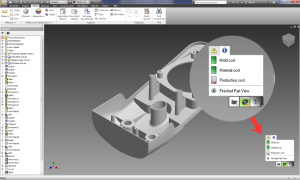
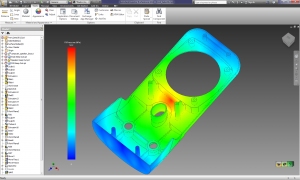
 I open up Creo Parametric, and load up a part model. Not too complex — some bosses, holes, and a bunch of blends. I select a blend (or “round,” to use PTC parlance), then click and drag its resizing handle. And wait. And wait. Eventually, after several seconds, the blend resizes. I wait some more, and the blend resizes again. Ad nauseum.
I open up Creo Parametric, and load up a part model. Not too complex — some bosses, holes, and a bunch of blends. I select a blend (or “round,” to use PTC parlance), then click and drag its resizing handle. And wait. And wait. Eventually, after several seconds, the blend resizes. I wait some more, and the blend resizes again. Ad nauseum. PTC will soon be releasing Creo 2.0, and, in anticipation of this, invited me (along with three other blogger/editors) to their corporate headquarters for a preview. Unlike a formal release presentation, which would be heavily scripted, our experience was much more extemporaneous. We got to see a good chunk of what’s new, hear about PTC’s underlying goals, and even talk about things we thought they should be doing better.
PTC will soon be releasing Creo 2.0, and, in anticipation of this, invited me (along with three other blogger/editors) to their corporate headquarters for a preview. Unlike a formal release presentation, which would be heavily scripted, our experience was much more extemporaneous. We got to see a good chunk of what’s new, hear about PTC’s underlying goals, and even talk about things we thought they should be doing better.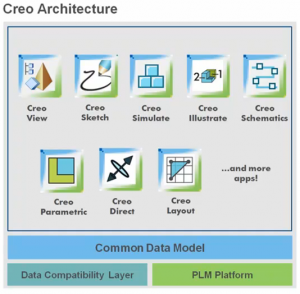 What to do? How to rationalize these seemingly irreconcilable things? The only reasonable answer is to offer customers what they want. For PTC, this required a new strategy: Offer a range of products sharing a common data model and a common user interface design, and allow users to choose whether they want to use history-based, direct, or any other form of modeling that might come along in the future.
What to do? How to rationalize these seemingly irreconcilable things? The only reasonable answer is to offer customers what they want. For PTC, this required a new strategy: Offer a range of products sharing a common data model and a common user interface design, and allow users to choose whether they want to use history-based, direct, or any other form of modeling that might come along in the future.